- Developers
- Developer Blog
- Software Development
- Website Design Cost: How Much to Design a Site?

profile

By Aran Davies
Verified Expert
8 years of experience
Aran Davies is a full-stack software development engineer and tech writer with experience in Web and Mobile technologies. He is a tech nomad and has seen it all.
Wondering what website design cost to expect for your next big software project?
In today’s digital world, websites continue to be the main hub for a business’ inbound marketing strategy. With advances in technology, design, and user experience pushing the boundaries of web development, companies need faster, more elegant, and more functional websites to make an impact in digital spaces.
However, while the need for a website is clearer now more than ever, what isn’t so clear is the cost associated with it. Website design costs can vary greatly from a few hundred dollars to as much as several hundred thousand depending on the scope of your project.
What Does the World of Contemporary Web Design Look Like?
In the vast interactive world of digital transactions, web design has occupied one of the most focal points in software development.
Nowadays, the chances that a business has of operating successfully in the virtual world of search engines with poor website designs is almost non-existent.
In this modern digital era, quality web design is no longer a coveted luxury or whimsical option meant only for a select few elitists: it’s a necessity.
Companies can’t afford to have a poor web design in this competitive digital market and the stats are quite revealing.
For starters, results obtained from three scientific studies have concluded that it takes roughly 50 milliseconds for a visitor to form an initial impression of your website, be it positive or negative.
What’s more, further stats indicate that nearly 90% of shoppers on Ecommerce websites (online stores) are more likely to return to a platform if they had a pleasant user experience.
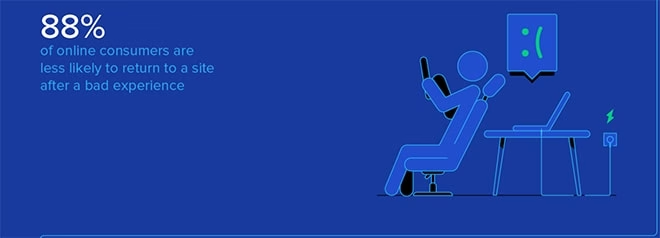
However, that’s not all.
Not only does research indicate that sub-par website designs have minimal chance of impacting positively on a business’ online web interaction with their customers, but it also shows that there are several elements that condition how contemporary web design should be carried out.
A B2B web usability report from Huff Industrial Marketing, KOMarketing, and Buyerzone revealed that roughly 64% of visitors to a website’s homepage expect to easily spot the company’s contact information somewhere on the page.
So much so, that they concluded around 44% of visitors will leave the website if they cannot source contact information on the home page.

The same report went on to shed light on the importance of optimizing web design for mobile phones. While mobile-unfriendly websites may not be a dealbreaker for some, it does impact the experience of most.
Bearing in mind the aforementioned, here is a breakdown of some of the most important trends which impact web design today. While these do not constitute must-haves, they do help in determining a website design cost as each one’s inclusion will play a factor in the overall price you pay:
Experimental Typefaces
In the dynamic discipline of user experience where online fonts are constantly improved upon, experimental typefaces have gained more popularity now than ever.

Get a complimentary discovery call and a free ballpark estimate for your project
Trusted by 100x of startups and companies like
These refer to unexpected modifications in letterform shape and spacing on a website. These range from varying x-heights, quirky lines, coloring, animations, or any shift in the way letters and space would typically be formatted on a website.
Experimental typefaces constitute a type of artwork for the website in which there is a constant need to balance art form and legibility. After all, as experimental as the typeface may be, it still needs to be eligible enough to get your message across to a reader.
Typically, experimental typefaces are minimal, often contrasted against a simple design in order to give it even more visual emphasis. This includes combining it with secondary typefaces which are easy to read.
Retro Fonts
Similar to experimental typefaces, retro fonts have also gained prominence in contemporary web design.
That said, by no means are they a new concept. In fact, retro fonts have been around for quite some time. However, usually, they have been discarded for more modern designs since retro font designs usually do not age well.
However, nowadays they have garnered some resurgence with a twist. By and large, it is not common in contemporary web design to see the exact style of retro font that was used in the past.
Instead, some graphic designers are now using retro fonts as a base upon which to build their creative designs, often fusing them with modern artistic traits to create a new, fresh work of art.
An example of this type of creative fusion between new and old can be seen on Spotify’s Carnival promotion page.

Credits: Spotify
They have combined traditional bold fonts with a moderately experimental background.
This type of retro-fusion creates a modern spin on a classical look, thus paving the way for even more unique and compelling designs that breathe life into long-forgotten font designs.
Parallax Scroll Animations
Parallax scrolling is a trend in web design that describes the juxtaposition between the movement of background content and that found on foreground content when one is scrolling on a webpage. Usually, the background content which is manipulated is an image, although that isn’t always the case.
Parallax scrolling has been trending in web design for the last several years. However, businesses who wish to incorporate it into their web design need to be aware that this trend tends to increase the overall website design cost due to its complexity.
Research has indicated that parallax scroll animations affect people who suffer from vestibular disorders since the illusion created can provoke unwanted dizziness and disorientation.
For that reason, there are a series of guidelines that one must bear in mind when designing this type of website design trend in order to avoid impairing a possible user’s experience when navigating your website.
These include:
- Ensuring that parallax scroll animations do not distract one from viewing important information.
- Not complicating a user’s ability to execute a given task.
- Keeping parallax scroll animations and their respective movements to a minimum.
- Localizing parallax scroll effects to a select area on the screen.
- Giving a user the option to disable parallax scroll animations.
3D Visuals
The introduction of high-resolution screens in the software viewing world has also shaped the production of 3D design.
Before, these design features were reputed for being unappealing and unnecessary distractions that had damaging effects on a website’s attractive feel. Nowadays, high-quality 3D designs are being interwoven into web designs with greater effect, having a positive impact on user experience.

Credits: Sirin Labs
As can be seen on the homepage design of Sirin Labs, the 3D globe creates a unique appeal to the site that gives the design the cutting-edge needed to make the site stand out.
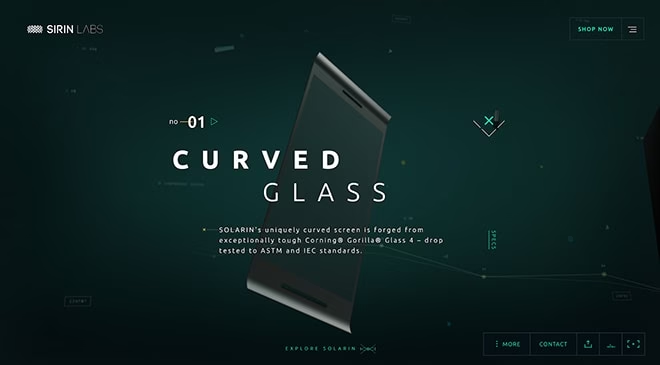
Credits: Sirin Labs
Similarly, on other pages on their website, they incorporate 3D animations with which users can interact. This encourages user engagement on a website, a key factor in boosting conversion rate.
Multimedia User Experience
At a time when internet quality and speed have improved exponentially over the years, web design trends all point to a surge in the use of multimedia to boost user experience.
Finally, websites can be designed to combine video, text, audio, and visuals to provide a multifaceted, rich user experience.
That said, as much as this type of communication strategy is trendy, moderation is key. Websites that overdo multimedia integrations on a site run the risk of producing a jarring effect on usability, often overwhelming or overloading persons who suffer from cognitive disorders.
What’s more, it’s imperative to format multimedia formats in such a way that the user is in control of the type of content they would like to take in. For example, disable auto-playing motion content and video.
Instead, include a clear option (usually signaled by the word ‘Play’) that grants the user the option to play or pause content at their own leisure.
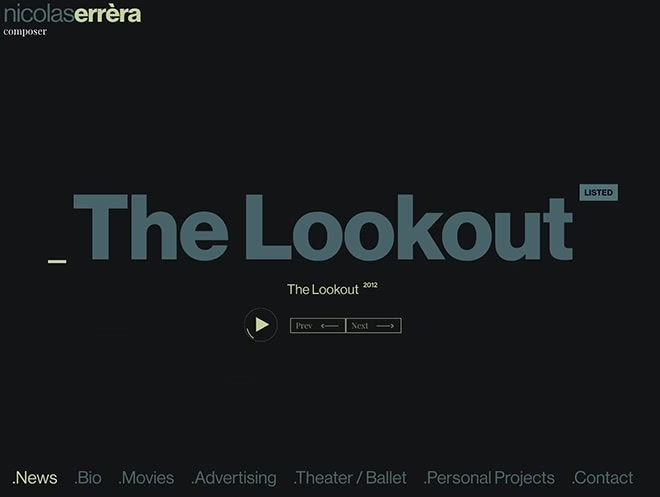
Credits: Nicolas Errèra
The website of the French composer Nicolas Errèra is a solid example of functional multimedia design.
The ‘Play’ button offers the user the option to pause and play the video in the background whenever they want, thus giving them the sense that they are in control of the information they wish to consume.
Understanding Website Design Cost
Website design costs usually range anywhere between $500 and $10,000 depending on how basic or elaborate the proposed design is.
Here’s a breakdown of how these prices can be categorized based on need and cost:
Basic Web Design ($500 – $2,500)
A basic web design usually constitutes anywhere from one (1) to five (5) mobile-responsive pages. These pages typically include a contact page built with a corresponding contact form as well as a landing page which tends to take the form of a homepage.
As the name suggests, basic web designs are very simple. They are ideal for freelancers and independent service providers looking for a professional website as well as micro-businesses looking to promote their services.
Since these are low-budget web design projects, the content on the web pages tends to be geared exclusively towards facilitating your business’ core goals and branding.
Hire expert developers for your next project
1,200 top developers
us since 2016
Consequently, it is customary for these pages to feature functionalities that promote purchasing, facilitate phone calls, quote requests, and more.
Intermediate Web Design ($2,500 – $5,000)
Intermediate web designs are multiple webpage compositions that are more elaborate in design and functionality than those seen in basic web designs.
To be more concrete, along with having more pages than basic web designs, intermediate web designs normally include the following additional features:
- Social media integration;
- Code configured to allow integration of Google Analytics and map tracking;
- Built-in order management systems;
- Live chat;
- Delivery tracking functionality;
- Software tools and integrations to facilitate Ecommerce management.
Needless to say, the inclusion of any of the features listed above will depend largely on whether the website is an Ecommerce (like Shopify) or not.
These types of websites are geared towards small-to-midsize businesses (business websites) or enterprises to help them drive performance.
In line with this, these types of web designs provide businesses with the right framework needed to support digital marketing strategies. These include a Content Management System (CMS) for copywriting projects, among others.
Advanced Web Design ($5,000 – $10,000+)
Advanced web designs are cutting-edge, innovative websites that are customized to suit one’s exact wants and needs.
In most cases, these types of web designs are database-driven, thus being destined for use by banks, architects, and big businesses which require lots of software data processing power.
Considering that these are bespoke web designs, they are characterized by extensive database population and integration, high-tech functionalities, numerous subpages, and more.
Clearly, from a design perspective, your website costs will be closely associated with the size of your company as well as the number of pages expected for your own website.
The more bandwidth or clientele your company has, the more demanding will be your software needs, hence an increase in the cost of website design.
Secondary Website Design Costs
In addition to the actual cost of producing a website design, there are a series of expenses that you need to cover.
These do not necessarily relate directly to the actual process of website design. Rather, they make reference to costs which one assumes indirectly when carrying out a website design.
These include:
Copywriting: Text is central to any website in order to communicate branding, services, and more. Irrespective of how basic or advanced your website’s design is, you will need to incorporate copywriting.
Depending on your budget, availability, or expertise, this may or may not involve contracting a copywriter to prepare the text that goes on the different web pages.
The typical price range for website copywriting goes from $300 to as much as $1500 for a few web pages. These prices will differ based on the skill, experience, and qualifications of the hired copywriter.
Domain Name: Domain names are integral aspects of a website’s identity. In fact, this is so true that at times, a business may wish to center its branding and image around its domain name. Sometimes, they may even change the name of the company if the domain name isn’t available!
Therefore, businesses need to pay a fee to secure their domain name. The cost of a domain name is linked to its demand. Domain names that are not particularly popular can cost anywhere from $10 – $100 annually. However, prices for those who are in high demand can ascend to several thousand dollars a year.
Hosting: In much the same way that you pay to rent a room or living space in a given area, you pay for your own site to occupy space on the internet. Therefore, as part of the design process, you will be required to host your website on a server.
The cost to do so varies from anywhere between $10 – $400 in accordance with the type of hosting you’re using. Shared hosting is the most budget-friendly, while cloud-based web hosting tends to be costlier.
UX/UI Research: You may be required to conduct research to obtain data that will be useful when preparing designs for websites.
This may involve paid user testing such as card sorting, in-person moderated sessions, or even carrying out a survey. The cost associated with this type of task will vary based on the investigative technique used.
Cutting Corners With Website Builders
One of the most common ways for businesses to avoid the financial expense of hiring web designers or a design team is to use a website builder.
These are do-it-yourself (DIY) software tools that enable you to set up an attractive-looking website in a short space of time.
They come with ready-made functionalities such as themes and plugins which allow you to build a site without the need to know how to code.
The Website builder provider is responsible for giving you web hosting. However, they do provide you with access to web hosting, but not all of them give it to you for free: some provide it at an additional cost. For example, WordPress requires you to pay for web hosting.
Therefore, that is not a cost that you would have to assume.
Usually, these website builders allow you to access a free version of their tool which enables you to build a basic website using the functionalities which are available.
However, to access more features, you would have to subscribe to the website builder’s billing plan.
For example, as part of their standard website plans, Wix offers a four-pronged payment service that includes different functionalities.
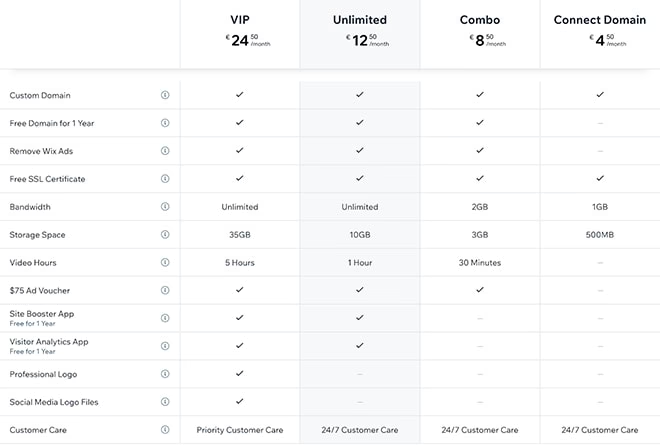
Credit: Wix
They also offer Business & Ecommerce plans which facilitate online payments since standard websites under the business’ other plan do not come with that functionality.
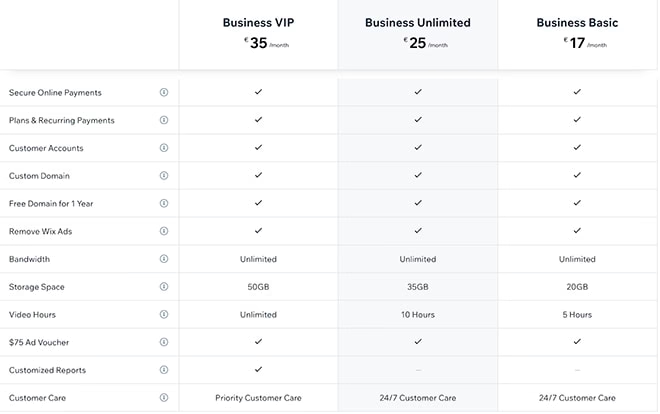
Credit: Wix
In the same vein, WordPress also offers a similar price breakdown, dividing its website builder services into four separate groups, in turn offering four different pricing plans.
Hire expert developers for your next project

To some businesses, having the option to set up a website in just a day sounds like an attractive possibility.
However, not all that glitter is gold.
The Drawbacks of Website Builders
While it is true that website builders do offer businesses a cost-friendly way to set a website up and running, they come with their fair share of setbacks:
- Reduced Mobile Experience: Guaranteeing top-quality experience for mobile users requires extensive code modification. Unfortunately, website builders do not come with the right optimization tools needed to boost the mobile experience nor do they allow for much code modification. With them, your customization options are limited. While it is true that website builders do tend to come with built-in mobile rendering features, it does not always result in smooth and attractive content and design relay.
- Difficult learning curve: As much as it may be easy to set up a website with a builder, any sort of in-depth personalization will be a painful process. Anytime you attempt to customize pages, resize images, or do anything atypical, it usually takes a significant amount of time to figure out how to do it with a website builder.
- Inflexible Templates: Most website builders come with a select few templates which hardly allow for much modification. This can be quite bothersome when it comes to preparing content for the website. If you are only allowed to put a certain amount of text in one specific section or a certain image size in another section, that can make web design much more restrictive than it has to be.
- Poor SEO functionalities: Contrary to popular belief, website builders never fully integrate lead generation or search engine optimization with your website when it is being built. While it is true that WordPress, for example, does have built-in characteristics which promote SEO, in general, they largely neglect important back-end coding elements that facilitate a solid SEO strategy. Options for accessing microdata are limited. Some do not allow for website schema integrations, and with those that do, the automatic generation tool misses out on key details.
In short, website builders are a decent alternative to custom-made websites, but only for a select few.
By and large, most businesses require much more flexibility in their content layout than what current website builders on the market are capable of producing, especially if these businesses want to scale their sites as they grow.
With that in mind, custom-built websites are a much better option for any and every company looking to digitize its services.
There is, however, one important question that needs to be answered:
Where can you get someone to create a web design for your business?
Before we get into where you can, let’s first address where you shouldn’t get a website designer.
Why You Should Avoid Popular Talent Platforms
Whenever businesses are looking for manpower to tackle a software project, the first instinct is to start your search on a freelance platform.
This is logical, as these spots usually feature several web developers. What’s more, you can hire them at a fairly inexpensive cost of $20/hour to complete your web design project and call it a day.
That sounds like a swell deal, right?
Not quite.
Freelance platforms and job boards alike are dangerous places to scout for talent.
Here’s why:
- Illegitimate professionals: While it is true that there are some credible software developers on these types of platforms, they are few and far between. Instead, every time you post a project, you’ll have to deal with the barrage of applications from suspicious web design service providers who claim to be experts in different areas of software development. However, they are all catfishing, hoping to lure unsuspecting businesses into disastrous collaborations for you where they take your money and render sub-par services.
- Poor candidate screening: One of the main reasons that these illegitimate service providers can get away with their tactics is that most of these platforms do not come with a method to screen candidates before they join. Therefore, it is left to you to assume the entire quality assurance screening process associated with recruitment, something which makes your onboarding task even more time-consuming.
- Unsuitable candidates: While you may come across some professionals who have the skills or technical knowledge needed to complete your web design, they may not have the right skills for project management. To be more exact, they may be good designers, but poor at time management, adhering to deadlines, or unfamiliar with how projects operate in general. Needless to say, candidates who are poor at sticking to deadlines are not the kind of professionals you want to align with, especially if time is a significant factor in your project.
- Difficult to effectively manage productivity: If you hire a candidate via a job board, the platform does not facilitate any way for you to measure or gauge the professional’s productivity on the job. Instead, it would be the responsibility of the candidate to report their progress on the project, and even then that does not quite paint a picture of how productive the candidate is being since they were hired.
Therefore, freelance platforms and job boards alike are not the ideal spaces for you to source top talent that’ll succeed in your software project.
Instead, you can start your search right here at DevTeam.Space.
Secure DevTeam.Space for Stellar Website Designs
DevTeam.Space is a vetted community of top software developers supported by an agile AI process that makes it easy to onboard high-quality talent in your project and guarantee its success.
Our community is teeming with product designers who specialize in creating compelling web designs for all types of businesses, including startups, small businesses, and even established, seasoned veterans looking to take their digital presence to the next level.
All of the product designers who make up our community of software experts have been specially chosen to join our ranks based on their skills, knowledge, experience, and desire to continue promoting the legacy of high-standard professional web design services that our spaces are known for.
What’s more, they are all backed by an agile AI algorithm process that equips them with the tools, functions, and organizational material needed to ensure smooth project management:
- Align the different phases of your web design cycle to individual milestones that represent the various stages of the development process.
- Access daily work overviews as well as weekly reports, all of which feature important updates that dictate the progress of the web designer that is in charge of your project.
- Easily identify hiccups in your web design workflow to make the task of correcting them much easier.
- Measure individual performance throughout all phases of the web design process to gauge employee productivity.
Partnering with product designs that are already predisposed to the Agile methodology by way of the Kanban principle assures you high productivity and a beautiful product.
What’s more, once the design phase is finished, you can also set up another one while partnering with our software developers to bring life to the completed design in an actual website development project.
All of our developers are supported by the same Agile AI algorithm which makes your project a success.
What’s more, DevTeam.Space also gives you the option to hire either a single web developer or an entire development team depending on your specific software needs.
All in all, where freelance platforms and job boards drop the ball when it comes to project management and quality talent, DevTeam.Space picks it up by connecting business owners to the services and professionals needed to take web design to the next level.
Ready to Estimate Website Design Cost?
This guide breaks down how to go about determining web design costs. Do your part by reviewing all of the information that we included above making sure to tailor each recommendation to your specific project to identify what is the best solution for you.
Under no circumstances should you sell your website design short. Do your utmost to connect with the best talent for your project. Read our guide on putting together a competent team of software developers.
DevTeam.Space can put you in contact with vetted expert product designers who are ready, willing, and able to take your website design to the next level.
Source them here. Take a few minutes to complete our DevTeam.Space questionnaire. An account manager from DevTeam.Space will reach out to you as soon as possible with a web design price so you can get started.
You can also secure a quote on development costs for a custom website to bring your vision to life.
FAQs on Website Design Cost
Website cost will depend on the features and functionalities you want to include in your website and the UI trends you want to include in your web pages. It can range from a few hundred dollars to a few thousand dollars. An accurate estimate can be provided by an experienced software development company.
Designing a single-page website can cost around a few hundred dollars. The website building and website maintenance services will be additional expenses.
Websites use different monetization methods. The popular one is by integrating ads. The revenue generated through ads can depend on cost-per-click, cost-per-impression, etc. Read more details on this blog.

Alexey Semeney
Founder of DevTeam.Space
Hire Alexey and His Team To Build a Great Product
Alexey is the founder of DevTeam.Space. He is award nominee among TOP 26 mentors of FI's 'Global Startup Mentor Awards'.
Alexey is Expert Startup Review Panel member and advices the oldest angel investment group in Silicon Valley on products investment deals.


